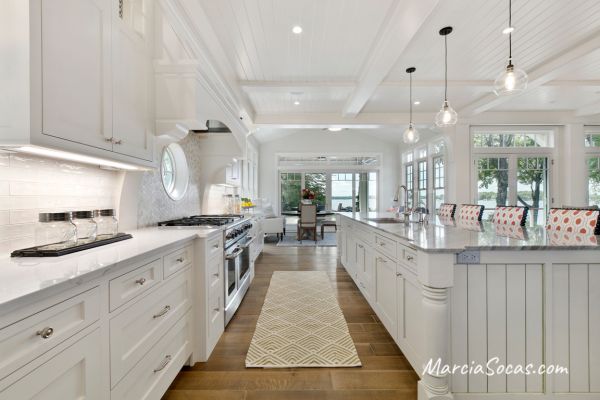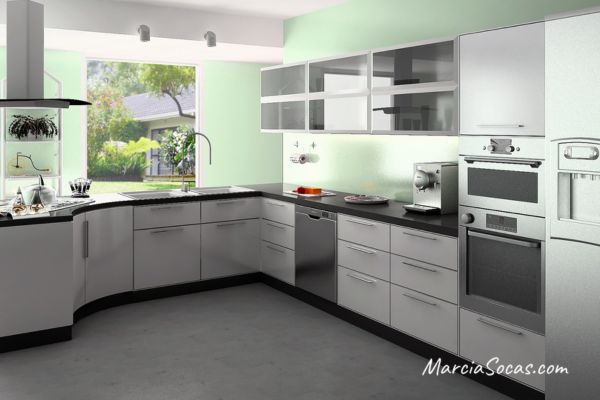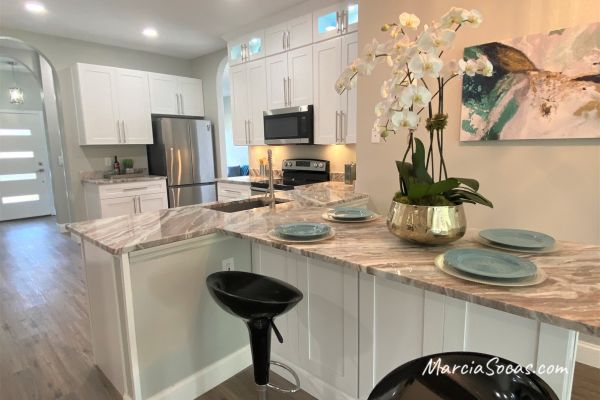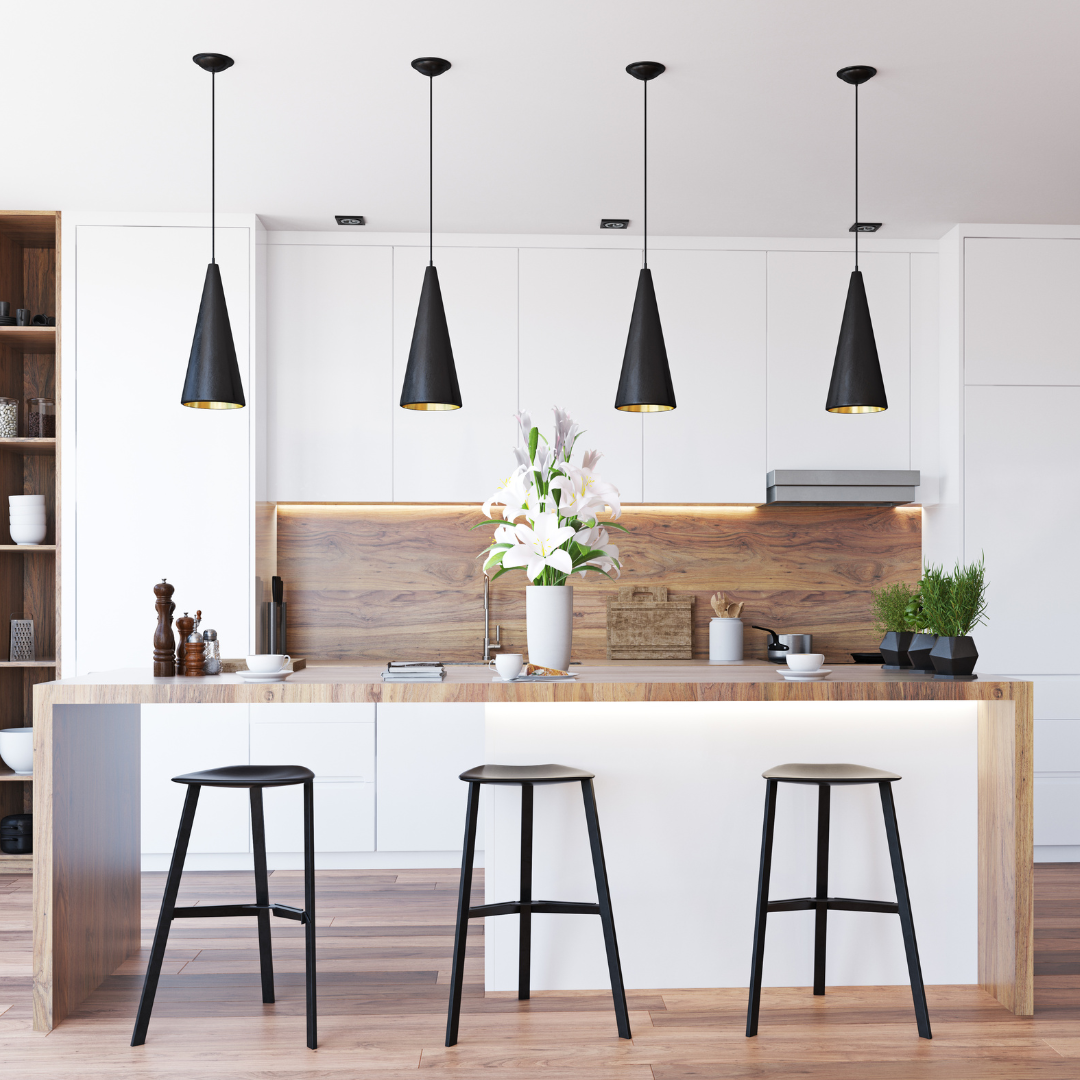Kitchen Design Principles
The kitchen is one of the most important rooms in the house and the heart of the home. It’s where we cook up tasty dishes and gather with family and friends. But have you ever wondered what makes a kitchen not just good for cooking but also really nice to look at?

Well, you’re in the right place because we’re going to talk about the main kitchen design principles and considerations for designing your dream kitchen. A well-designed kitchen can be both functional and stylish, and it can make cooking (and cleaning) a more enjoyable experience.
Throughout my site I provide affiliate links to products that I hope will help you with your DIY project supplies. As an Amazon Associate, I earn from qualifying purchases. This means that I may receive a small commission if you use these links to purchase products, but it does not change your price in any way.
The 3 Principles of Kitchen Design
1. Space Planning
The first step and one of the basic principles of kitchen layout is to think about how you want to use the space. Do you want a big kitchen island for food preparation? A breakfast bar for casual dining? A dedicated cooking area? Once you know what you need, you can start to plan the layout.
- Make the Most of Your Space: It’s all about using your kitchen space efficiently. Think about how you move around while cooking. Make sure you can easily get to the stove, sink, and fridge without doing the kitchen shuffle.
- Work Zones: Divide your kitchen into zones based on what you do there. One zone for prep work, another for cooking, and a spot for storage. This way, you won’t be running around like crazy while making dinner.
There are a few different kitchen layouts to choose from, including…
Kitchen Layouts
Galley: The galley kitchen is the most common type of kitchen layout especially for small spaces. It is a long, narrow kitchen with appliances and cabinets arranged on opposite walls. This layout is ideal for small kitchens because it maximizes the space. However, it can be cramped if the kitchen is too small.

L-shaped kitchen: The L-shaped kitchen is a great option for medium-sized kitchens. It has appliances and cabinets arranged in an L-shape, which creates a more spacious feel than the galley kitchen. This layout also provides more counter space and storage space.

U-shaped kitchen: The U-shaped kitchen is the most spacious kitchen layout. It has appliances and cabinets arranged in a U-shape, which creates a large work area. This layout is ideal for large families or people who cook a lot.

Island kitchen: The island kitchen has an island in the center, which can be used for meal preparation, cooking, or dining. This layout is ideal for large kitchens and for people who want a more open and social kitchen. However, it takes up more space than other layouts.

Peninsula kitchen: The peninsula kitchen has a peninsula that juts out from one wall. This layout is similar to the island kitchen, but it takes up less space. It is a good option for people who want a more casual kitchen.

Here are some additional factors to consider when choosing a kitchen layout:
- The number of people who will be using the kitchen
- The amount of cooking you do
- Your budget
- Your personal style
No matter what layout you choose, make sure it is functional and comfortable for you and your family.
2. The Work Triangle
The work triangle is a concept in kitchen design that refers to the distance between the three main work areas in the kitchen: the sink, the stove, and the refrigerator. The ideal distance between these three points is 3 to 9 feet. This allows for efficient movement between the different work areas. If the work triangle is too large, it can be inefficient and inconvenient. If shorter distance, it can be cramped and uncomfortable.
When designing your kitchen, it’s important to consider the work sequence and make sure that the appliances and work areas are arranged in a way that makes sense.

Keep It Easy to Move: Be careful about where people usually walk in your kitchen. Don’t put your work kitchen triangle where everyone’s always passing through. If you can, add an island to keep your cooking area separate from where people hang out.
3. Work Sequence
The work sequence is another important concept in kitchen design. It refers to the order in which you typically use the different appliances and work areas in the kitchen.
For example, the typical work sequence for cooking might be:
- Wash your hands at the sink.
- Prepare your ingredients on the countertop.
- Cook your food on the stovetop or in the wall oven.
- Clean up dirty dishes at the sink.
So think about the order you do things in the kitchen. Put storage space or kitchen cabinets close to where you enter so you can grab pots, pans, and ingredients easily. Have your prep area near the sink for easy washing and chopping. And keep the stove and oven close by for quick access when you’re cooking up a storm.

Some important kitchen design considerations:
Ventilation above your stove
A good ventilation system is essential for any kitchen, especially if you cook a lot. The ventilation system will help to remove smoke, grease, and other cooking odors from the air. There are two main types of ventilation systems for kitchens: range hoods and downdraft ventilation systems.
Design and position of the kitchen island
Kitchen islands can be a great way to add extra counter space, storage, and seating to your kitchen. When designing the kitchen island, it’s important to consider the size and shape of the island, as well as its position in the kitchen. It should be placed in a location that is convenient for cooking, food prep, and dining. It should also be placed in a location that does not block traffic flow in the kitchen.
- Size: The size of the kitchen island will depend on the size of your kitchen and your needs. If you have a small kitchen, a small island may be the best option. If you have a large kitchen, you can have a larger island that accommodates more people and a seating area or provides more food storage areas.
- Shape: The shape of the kitchen island can also vary. Some popular shapes include rectangular, square, and L-shaped islands. The shape of the island should complement the overall style of your kitchen.
- Position: The position of the kitchen island is also an important factor. It should be placed in a location that is convenient for cooking, food prep, and dining. It should also be placed in a location that does not block traffic flow in the kitchen.
In this renovation pictured below, the dining area was small so we built a kitchen countertop that extended into the dining area, increasing the visual size of the kitchen and making the space more functional:

Cabinets
You need plenty of storage so cabinets are essential! For storing food, dishes, and other kitchen items. When choosing cabinets, it’s important to consider the size, style, and materials of the cabinets.
- Size: The size of the cabinets will depend on the amount of storage space you need. If you have enough space, you may need to choose smaller cabinets. If you have larger spaces you may be able to get away with larger cabinets.
- Style: The style of the cabinets should complement the overall style of your kitchen. There are many different styles of cabinets available, so you can find one that fits your taste.
- Materials: The materials of the cabinets will affect the durability and maintenance requirements of the cabinets. There are many different materials available, so you can choose one that fits your budget and personal preferences.
Appliances
The appliances you choose will have a big impact on the functionality of your kitchen. When choosing appliances, it’s important to consider your needs and budget.
- Your needs: Think about how you cook and what appliances you need. Do you need a gas stove or an electric stove? Do you need a dishwasher or a washing machine? Do you need a coffee maker? Microwave ovens?
- Your budget: Appliances can be expensive, so it’s important to set a budget before you start shopping.
- The size of your kitchen: The size of your kitchen will also affect the size of the appliances you can choose. If you have a small kitchen, you may need to choose smaller appliances.
Lighting and windows for air
Good lighting and ventilation are essential for any kitchen. When designing the lighting and ventilation for your kitchen, it’s important to consider the size and layout of the kitchen, as well as the amount of natural light that the kitchen receives.
- Lighting: The amount of lighting you need will depend on the size of your kitchen and the activities you do in the kitchen. If you do a lot of cooking, you will need more lighting than if you only use the kitchen for occasional meals. You can also put under-cabinet lighting for an aesthetic look.
- Ventilation: The amount of ventilation you need will depend on the amount of cooking you do and the type of appliances you have. If you cook a lot with oil or grease, you will need more ventilation than if you cook with more delicate foods.

Sink
The sink is one of the most important appliances in the kitchen, so it’s important to choose a location that is convenient for food prep and cleanup. The sink should also be located near the dishwasher and garbage disposal if you have them.
- Place the sink near a window: This will help to provide natural light and ventilation, which is important for food safety.
- Avoid placing the sink near the stove: This can be a safety hazard, as hot grease or liquids can easily spill over and cause a fire.
- Make sure the sink is easy to access: The sink should be located in the right place where you can easily reach it, even if you are carrying heavy pots or pans.
This sink from Amazon is my favorite for my home renovation projects.
Trash
The trash can should be placed in a location that is convenient for waste disposal, but out of the way of food preparation.
- Place the trash can near the sink: This will make it easy to dispose of food scraps and other waste.
- Make sure the trash can has a lid: This will help to contain odors and prevent pests.
Fire extinguisher
A fire extinguisher is an essential safety device for any kitchen. It should be placed in a location that is easily accessible, but out of the way of traffic.
- Place the fire extinguisher near the stove: This is where fires are most likely to start.
- Make sure the fire extinguisher is visible: You should be able to see it easily in case of an emergency.
Entry doors
The entry door to the kitchen should be wide enough to have available space to allow for easy passage of people and large appliances. It should also be located in a place where it is not blocked by furniture or other obstacles.
- Make sure the entry door is wide enough: This will prevent you from having to squeeze through the door when carrying heavy items.
- Place the entry door in a convenient place and location: The door should be located in a place where it is easy to access from the rest of the house.
Adding Your Personal Touch
Finally, don’t forget to add your personal touch to your own kitchen. Hang up some artwork, use unique cabinet handles, or show off your favorite dishes on open shelves. Your kitchen should be a space that you love spending time in, so make it your own!
Don’t be afraid of personalizing your kitchen. Here’s how I personalized mine–after 15 years of living here I FINALLY decided to make it my own. And now I love walking into the kitchen every day.



With some careful thought and a bit of your own personal touch, your dream and new kitchen are closer than you think. Here’s to your perfect kitchen and all the wonderful times it will host!
Other Kitchen Projects you may like:
How I Paint Kitchen Countertops to Look like Marble
How A DIY Shiplap Backsplash Saved my Kitchen Reno
4 Amazing 80s Kitchen Cabinet Makeovers
How to Style Open Kitchen Shelves
Kitchen Redesign–Condo Kitchen Remodel Before and After